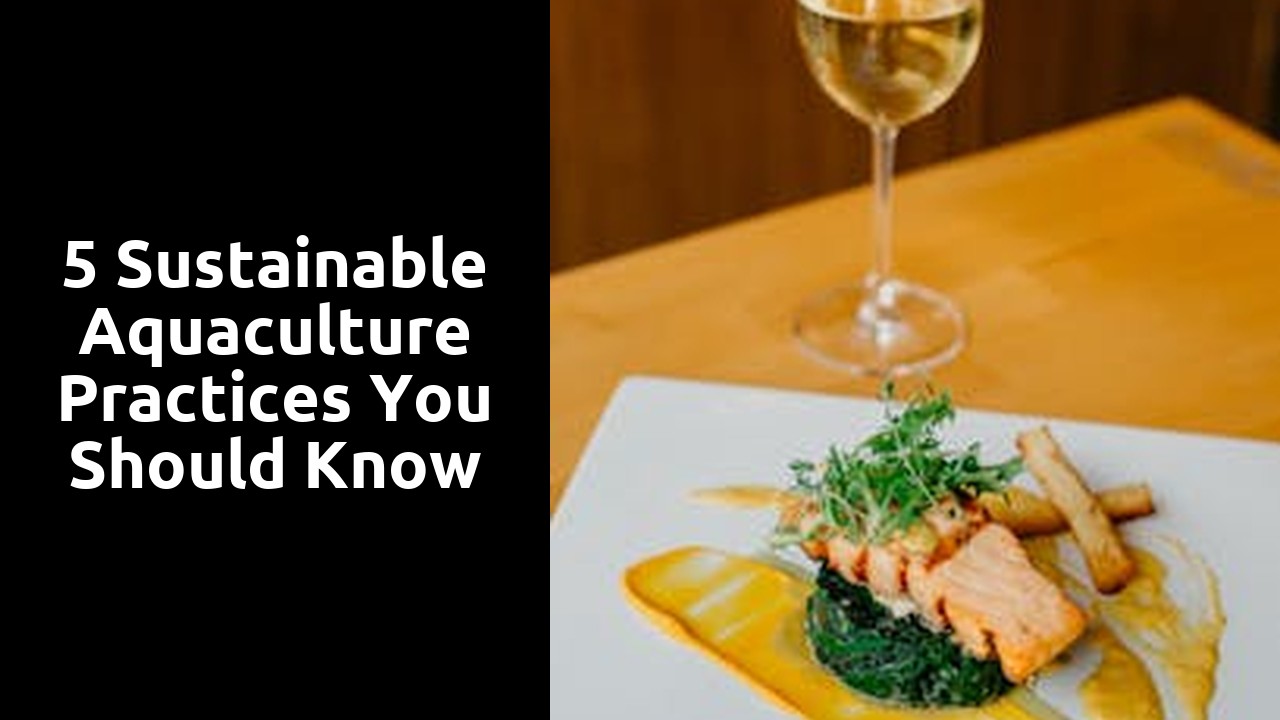5 Sustainable Aquaculture Practices You Should Know

Addressing Challenges in Sustainable Aquaculture
To successfully navigate the complexities of sustainable aquaculture, it is essential to approach the challenges with a strategic mindset and a commitment to innovation. One of the primary obstacles faced by aquaculture practitioners is the issue of waste management, especially in densely populated farming areas. Developing efficient waste recycling systems and implementing stricter protocols for waste disposal are critical steps towards enhancing the sustainability of aquaculture operations.
Moreover, maintaining biodiversity and ecosystem balance poses another significant challenge in sustainable aquaculture. Intensive fish farming practices can lead to genetic pollution and the displacement of native species. Adopting integrated multi-trophic aquaculture systems and promoting the conservation of natural habitats can help mitigate these negative impacts and foster a more sustainable approach to aquaculture.
Managing Water Quality and Pollution
Water quality is paramount in sustainable aquaculture practices. Maintaining the right balance of dissolved oxygen, pH levels, and nutrients in water bodies is critical for the health and growth of aquatic species. Regular monitoring and analysis of water parameters help aquaculturists ensure a suitable environment for their stock. By employing advanced filtration systems and implementing proper waste management strategies, farms can minimise the impact of pollution on surrounding ecosystems.
Pollution prevention is a key aspect of responsible aquaculture. Controlling the discharge of effluents and reducing the use of chemicals such as antibiotics and pesticides can significantly mitigate negative environmental effects. Implementing Best Management Practices (BMPs) and adopting eco-friendly technologies contribute to safeguarding water quality and biodiversity. Collaboration between industry stakeholders, researchers, and governing bodies is essential to uphold high standards of water stewardship in aquaculture operations.
Government Regulations and Sustainable Aquaculture
Government regulations play a pivotal role in ensuring the sustainability of aquaculture practices. By setting clear guidelines and standards, authorities help to monitor and control the industry's impact on the environment. These regulations cover diverse aspects such as site selection, waste management, and disease control, all aimed at minimising negative effects on habitats and wild fish populations. Compliance with these rules is essential for the long-term viability of aquaculture systems.
Moreover, government intervention extends to supporting research and development initiatives that focus on improving farming methods and reducing the industry's ecological footprint. Financial incentives and grants are often provided to encourage innovation in areas such as feed formulation, energy efficiency, and ecosystem conservation. By harnessing the power of policy frameworks, governments can steer the aquaculture sector towards more sustainable practices, ensuring the well-being of marine ecosystems and future seafood supply.
Compliance with Aquaculture Stewardship Council Standards
Compliance with standards set by the Aquaculture Stewardship Council (ASC) is paramount in ensuring sustainable aquaculture practices. The ASC provides a set of guidelines that farms must adhere to in order to promote responsible environmental and social practices within the aquaculture industry. This includes requirements such as minimizing the use of antibiotics, managing water quality effectively, and ensuring good animal welfare practices are in place. By complying with these standards, aquaculture farms can show their commitment to sustainable and ethical practices in seafood production.
Consumers are increasingly looking for seafood products that are certified by the ASC, as this signifies that the product has been produced in a way that minimizes environmental impact and supports local communities. Holding the ASC certification provides a competitive edge in the market, as it demonstrates a commitment to sustainability and responsible aquaculture practices. As consumer awareness of sustainable seafood choices grows, the demand for products that meet ASC standards is also on the rise. This shift in consumer preferences is driving more aquaculture farms to seek ASC certification, leading to a positive impact on the overall sustainability of the industry.
Consumer Awareness and Sustainable Seafood Choices
Consumer awareness plays a crucial role in promoting sustainable seafood choices. As consumers become more conscious of the environmental impact of their food consumption, there is a growing demand for sustainably sourced seafood products. By choosing seafood that is certified by reputable organisations such as the Aquaculture Stewardship Council (ASC) or Marine Stewardship Council (MSC), consumers can actively support fisheries and aquaculture practices that adhere to high standards of sustainability.
Making informed choices about seafood consumption also involves understanding the importance of biodiversity conservation and responsible fishing practices. By opting for species that are abundant and not at risk of overfishing, consumers can contribute to maintaining healthy marine ecosystems. Additionally, supporting local and small-scale fisheries can help reduce the carbon footprint associated with seafood transportation, promoting a more sustainable seafood supply chain.
Promoting Responsible Consumption Practices
Consumers play a significant role in promoting sustainable aquaculture practices by making informed choices about the seafood they consume. When consumers actively seek out seafood products that are certified sustainable, they are supporting aquaculture operations that adhere to high environmental and ethical standards. This demand for sustainably sourced seafood not only encourages responsible practices within the industry but also helps to protect marine ecosystems for future generations to enjoy.
Choosing seafood from well-managed aquaculture facilities and fisheries can make a real difference in reducing overfishing and mitigating the environmental impact of seafood production. By selecting products that bear labels such as the Aquaculture Stewardship Council (ASC) certification or Marine Stewardship Council (MSC) certification, consumers can ensure that they are supporting operations that are committed to sustainability. Additionally, educating oneself about sustainable seafood choices and advocating for better industry practices can empower consumers to drive positive change towards a more environmentally conscious and responsible seafood industry.
Related Links
Review of Aquaculture Certification and LabelingThe History of Aquaculture Practices
Roundup of Sustainable Aquaculture Practices
Why Aquaculture Environmental Impact Should Be Considered
Why Sustainable Aquaculture Practices Matter
What Are the Environmental Impacts of Aquaculture?
What Are the Best Aquaculture Practices for Sustainability?
How to Minimize Environmental Impact of Aquaculture